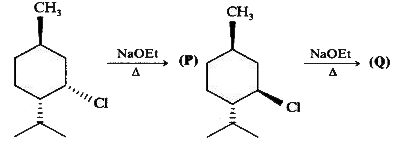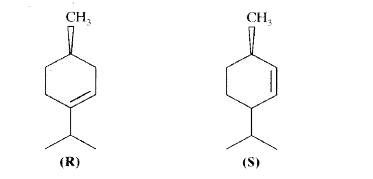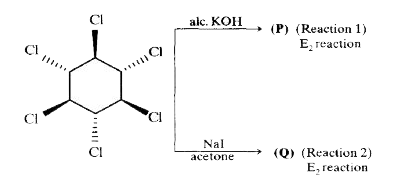Complete Solutions to Additional Objective Questions (Single Correct Choice Type) of chapter ALKENES AND ALKYNES I of Class 12 book with complete answers and questions
| Class 12 | CHEMISTRY |
| Chapter | ALKENES AND ALKYNES I |
| MS CHOUHAN | Additional Objective Questions (Single Correct Choice Type) |
| Number Of Questions | 44 |
| Academic Year | 2023-24 |
Major product of the following reaction is

View SolutionSelect the major product from the following reaction sequence.

View SolutionThe following reaction proceeds by which mechanism ?

View SolutionReagent used to carry out following conversion from alkyne to alkene is

View SolutionThe reagent(s) for the following conversion is/are

View SolutionConsider the following reaction:

Identify product (P) and (Q) from the folowing compounds:

View SolutionChoose the compound with the (S) chiral carbon and the (Z) double bond configuration
View SolutionThe synthesis of 3-octyne is achieved by adding a bromoalkane into a mixture of sodium amide and an alkyne. The bromoalkane and alkyne, respectively, are
View Solution
Products (P) and(Q) are
View SolutionThe following reaction proceeds by which mechanism ?

View SolutionConsider the following reaction:

If (P) on heating isomerizes to (Q). What is the structure of (Q) ?
View SolutionChoose the structure that has the name (R, Z)-2-bromo-4-mrthyl-2-phenylhex-4-ene.
View SolutionIdentify the final product in the reaction
`C_(6)H_(5)-underset(underset(OH)(|))overset(overset(C_(6)H_(5))(|))C-underset(underset(OH)(|))overset(overset(CH_(3))(|))C-CH_(3)underset(Delta)overset(H^(+))rarr?`
View SolutionWhich of the following alkene is most stable ?
View SolutionHow many halogen atoms will be removed in the following `E_(2)` reaction ?

View SolutionWhat is the major product of the following reaction ?

View SolutionThe following reaction proceeds by which mechanism ?

View SolutionWhich of the following carbocation will undergo rearrangemment ?
View SolutionThe most reactive conformation for an E2 reaction is
View SolutionIn the following sequence of reactions
`CH_(3)CH_(2)CH_(2)Broverset(KOH(alc))rarr(A)overset(HBr)rarr(B)overset(KOH(aq.))rarr(C),`
The product ( C) is
View SolutionWhich of the reactions can not be used to synthesize propyne ?
View SolutionConsider the following compounds
(I) `CH_(3)-underset(underset(CH_(3))(|))overset(overset(CH_(3))(|))C-Br`
(II) `CH_(3)-underset(underset(CH_(3))(|))C-Br`
(III) `CH_(3)-CH_(2)-CH_(2)Br`
Their reactivity toward E1 is
View SolutionMajor product of the following reaction is

View SolutionSelect the major product from the following reaction sequence.

View SolutionThe following reaction proceeds by which mechanism ?

View SolutionReagent used to carry out following conversion from alkyne to alkene is

View SolutionThe reagent(s) for the following conversion is/are

View SolutionConsider the following reaction:

Identify product (P) and (Q) from the folowing compounds:

View SolutionChoose the compound with the (S) chiral carbon and the (Z) double bond configuration
View SolutionThe synthesis of 3-octyne is achieved by adding a bromoalkane into a mixture of sodium amide and an alkyne. The bromoalkane and alkyne, respectively, are
View Solution
Products (P) and(Q) are
View SolutionThe following reaction proceeds by which mechanism ?

View SolutionConsider the following reaction:

If (P) on heating isomerizes to (Q). What is the structure of (Q) ?
View SolutionChoose the structure that has the name (R, Z)-2-bromo-4-mrthyl-2-phenylhex-4-ene.
View SolutionIdentify the final product in the reaction
`C_(6)H_(5)-underset(underset(OH)(|))overset(overset(C_(6)H_(5))(|))C-underset(underset(OH)(|))overset(overset(CH_(3))(|))C-CH_(3)underset(Delta)overset(H^(+))rarr?`
View SolutionWhich of the following alkene is most stable ?
View SolutionHow many halogen atoms will be removed in the following `E_(2)` reaction ?

View SolutionWhat is the major product of the following reaction ?

View SolutionThe following reaction proceeds by which mechanism ?

View SolutionWhich of the following carbocation will undergo rearrangemment ?
View SolutionThe most reactive conformation for an E2 reaction is
View SolutionIn the following sequence of reactions
`CH_(3)CH_(2)CH_(2)Broverset(KOH(alc))rarr(A)overset(HBr)rarr(B)overset(KOH(aq.))rarr(C),`
The product ( C) is
View SolutionWhich of the reactions can not be used to synthesize propyne ?
View SolutionConsider the following compounds
(I) `CH_(3)-underset(underset(CH_(3))(|))overset(overset(CH_(3))(|))C-Br`
(II) `CH_(3)-underset(underset(CH_(3))(|))C-Br`
(III) `CH_(3)-CH_(2)-CH_(2)Br`
Their reactivity toward E1 is
View Solution
Additional Objective Questions (Single Correct Choice Type) questions and complete solutions for chapter ALKENES AND ALKYNES I of MS CHOUHAN CHEMISTRY (HINGLISH) of Class 12